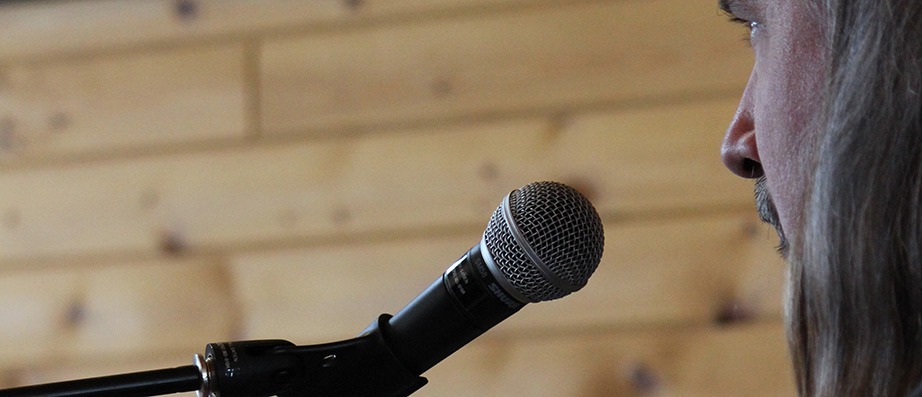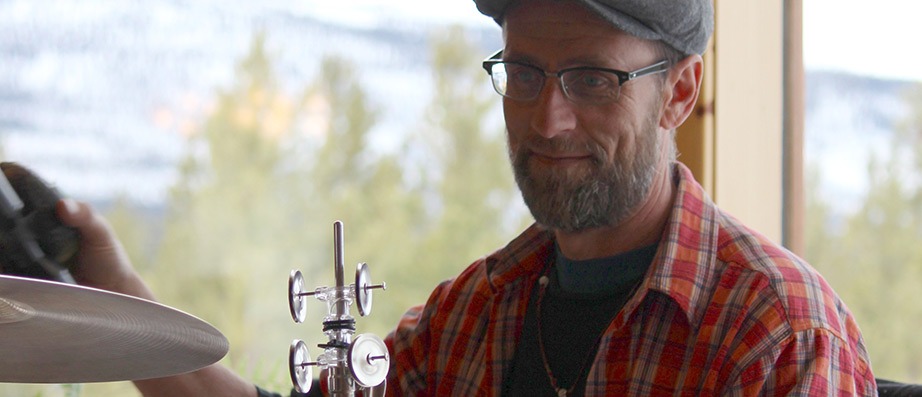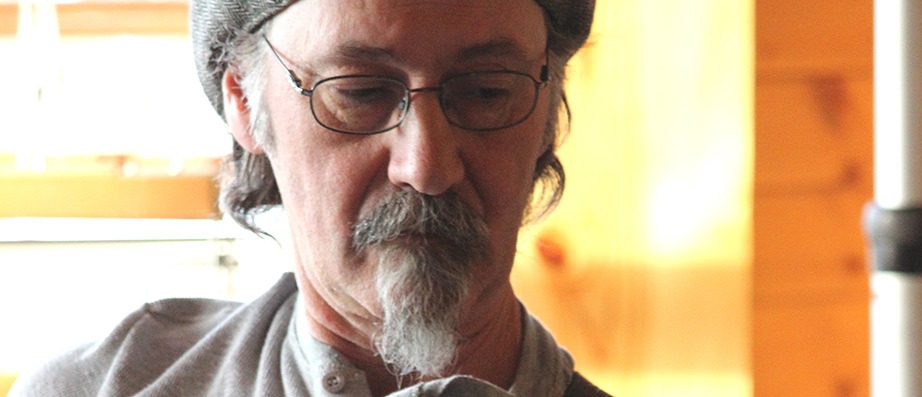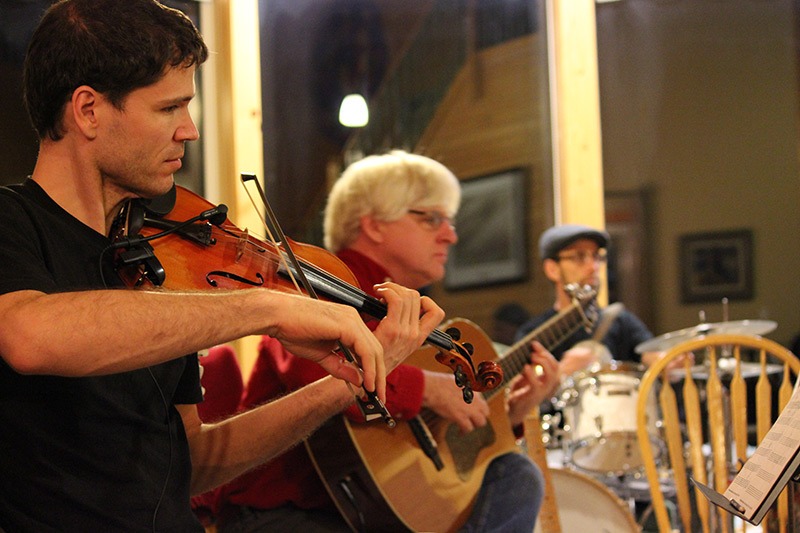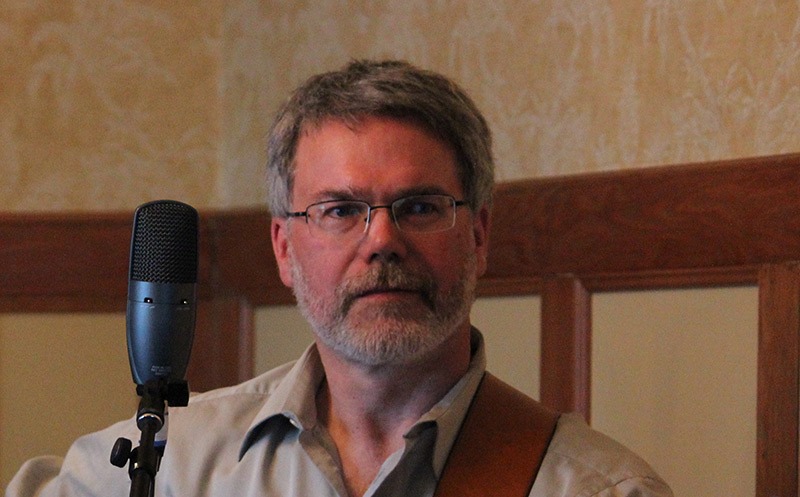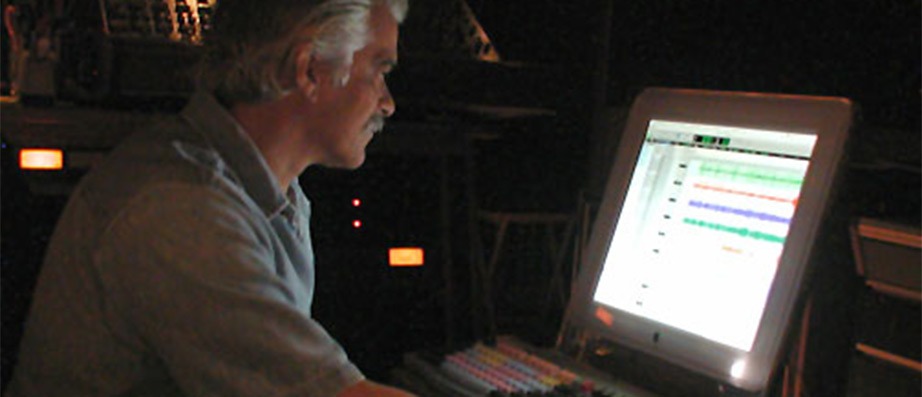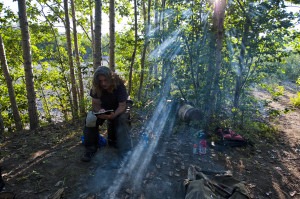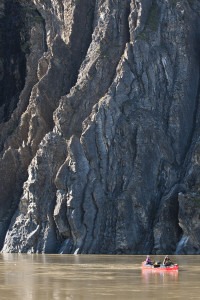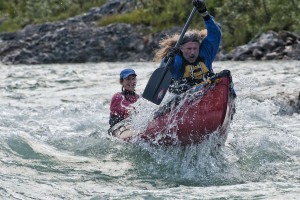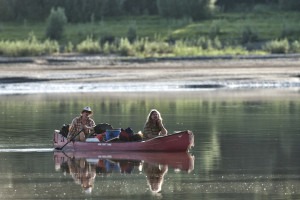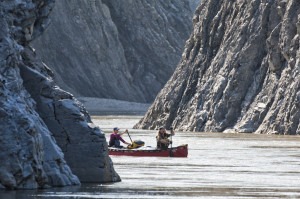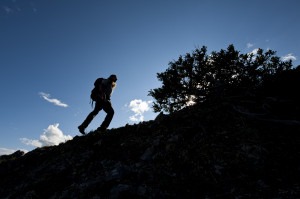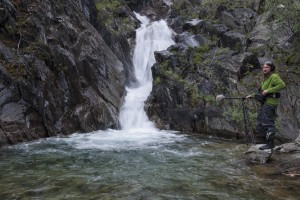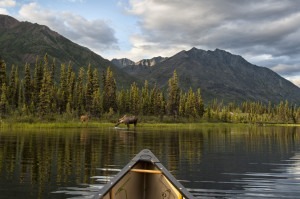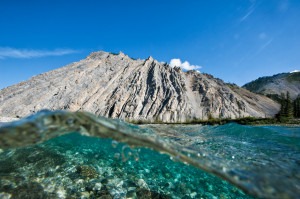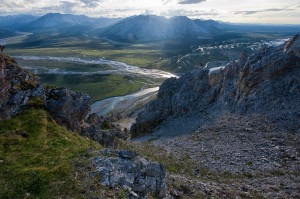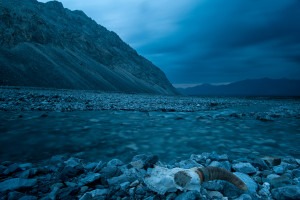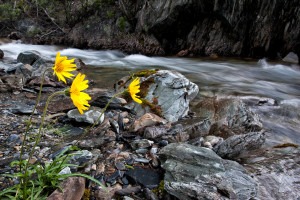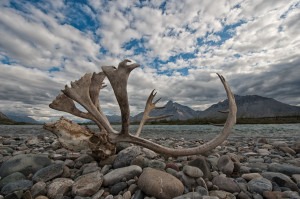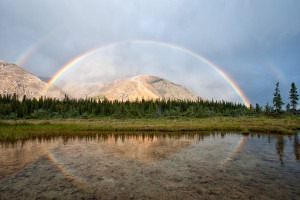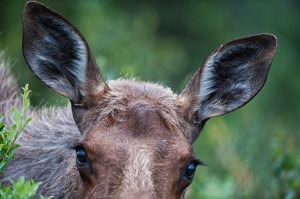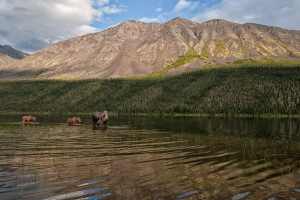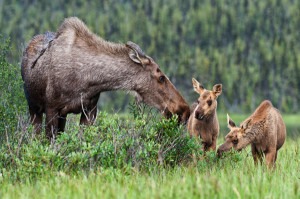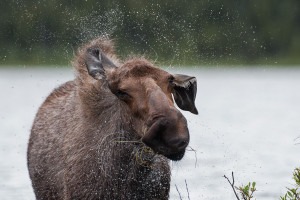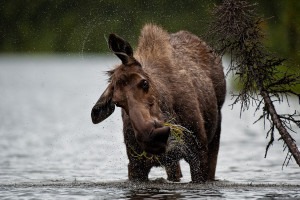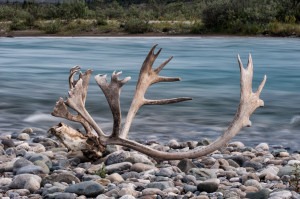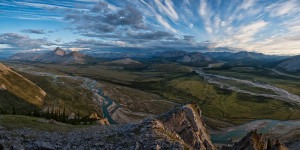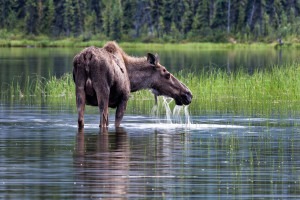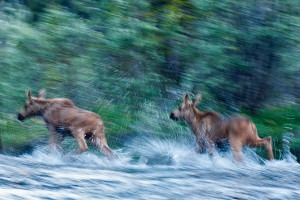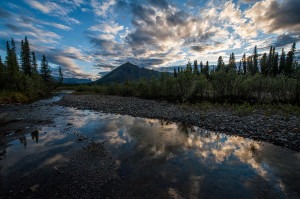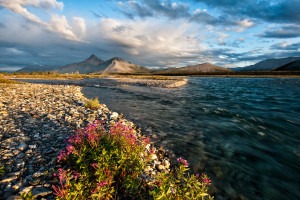THE INSPIRATION
It seemed impossible! In 24 hours, I had gone from Beijing, China (on the smoggiest day in recorded history) to the pristine headwaters of the Peel River Watershed in Canada’s Yukon.
The floatplane touching down on McClusky Lake—and the immediate greeting by a mother moose and her two calves—seemed both surreal and exceedingly vivid. In the cities where most of us live, we just don’t see colours, animals, mountains, waters and skies like these.
And that’s why we came. My fellow artists and I hoped to convey the essence and magnificence of Canada’s Peel River Watershed through music, sound and imagery, so that others could experience and treasure this wilderness.
Despite overwhelming opposition from a vast majority of Yukon communities and indigenous groups, the current Yukon government has indicated that extensive mining, oil and gas and other industrial development may soon occur within the Peel River Watershed. This knowledge further fuelled our commitment.
Three weeks, 550 kilometers of paddling and countless memorable experiences later, I had a notebook full of lyrics and compositions, several hours of digital 3D recordings, and a head full of music. This was already a satisfying accomplishment, but the bigger challenge lay ahead: All this music and sound was to be combined with the stunning imagery of photographer Peter Mather and visual artist Stephanie Ryan, as our collective experience was transformed into a series of multimedia concerts.
Weeks of studio preparation and intensive collaborative rehearsals with some of North America’s finest musicians resulted in sold-out concerts, where we had successfully shared both the majesty and the fragility of the Peel River’s wilderness—truly one of Earth’s few remaining sacred spaces.
Job well done! Time to sit back and relax, right?
Not so fast…
The overwhelming audience response and desire to share this music of the Peel River Watershed led us to recognize our greater responsibility to a wider audience. We all agreed that the music we had created was worthy of being professionally recorded and published as a CD.
But we cannot do this without you.
Please help us meet the final challenge of our long journey. Together we can spread this musical message of preserving wilderness and culture!
Information about the musicians involved, song demos, and a video of “Dragon at the Stony Gates” are all found below.
We thank you for taking the time to read this, and for your interest in the Peel River Watershed. But in truth, reading about wilderness is not enough: honouring wilderness requires full-on engagement.
So grab your paddle (metaphorically speaking), and let’s run these final rapids together!
~Matthew Lien
“HEADWATERS” ~ HOW WE CAME BY THE CD TITLE
The album title comes from the Gwichin aboriginal name for the five rivers that flow into the Peel River. They call this vast watershed “choo tlit”, meaning “headwaters”. As I paddled down the Wind River (one of the five) into the Peel and watched as the river grew in size, I realized these were among the most important headwaters of the entire planet! These waters were flowing forth to quench a thirsty world. What could be more precious and worthy of preservation?
Matthew Lien and members of the Wildlands ensemble are interviewed by Dave White on CBC’s Airplay.
HELP US PRESERVE ONE OF OUR EARTH’S LAST-REMAINING PRISTINE WILDLIFE HABITATS.
CD AUDIO SAMPLES
Introduction: This song was composed while flying into the headwaters of the Peel River, specifically into the upper Wind River.
The intended music treatment: The song begins with a contemplative pulse, with the acoustic guitar and hand percussion gradually building in intensity, and then the viola and violin embracing the melody as the song shifts between tension and calm, finally blossoming into a soaring surrender.
The story: After flying from Beijing to Vancouver and on to Whitehorse, and then driving for five hours to the floatplane dock in the village of Mayo (pop. 400) in central Yukon, I eagerly expected some kind of enviro-shock. Flying in the de Havilland Twin Otter with my six paddling partners—the float plane overloaded inside with expedition gear and outside with canoes strapped to the studs—I anticipated looking out over untouched wilderness just 24 hours after leaving a city of 20 million people.
I mean, whoa!… 20,000,000 to 400 in 24 hours flat!
But to my dismay, I could still see scars on the land. Even here, survey lines and exploration roads stretched as far as I could see. Humanity’s hand has grown long.
But gradually, after an hour or so of flying, the rugged mountains of the upper headwaters approached like mighty ocean waves of sculpted stone lapping dangerously close to the bottom of our plane. The scars vanished and a pristine wilderness revealed itself.
Now I could bask in my enviro-shock.
Looking out on this primeval paradise, the words of aboriginal Gwichin Elders Robert and Dorothy Alexie came to me, speaking of the hardships their ancestors endured while living here.
Hard though it was, this was home. And it still is.
Introduction: Composed at our camp on McClusky Creek where it flows into the upper Wind River, the music reflects the excitement we felt after portaging from McClusky Lake to the creek and a long day of lining boats downstream to the confluence. This was where we’d finally get our paddles wet!
The intended music treatment: The song opens with Robert Alexie recalling how, when he was a child, nobody had ever seen a map before, and how he’d learned everything about the land from his father and his grandfather through their many stories. Those stories were a kind of parchment transferring awareness of every turn of every river, every creek, every ridge, every camp and every gravesite with absolute intimacy. He then recalls how he felt when he first saw a map of his country, like a “God’s eye view” of what he’d already seen within his mind. After thousands of years of story telling, this was a culture-changing experience.
The lyrics and the music of “Discovery” present a confident storyteller, like the voice of the land itself welcoming and cautioning visitors to the watershed. The drums and bass set up a solid groove, with piano and guitar carrying the lyrics. The violin accentuates the melody and rhythm, occasionally breaking away in swinging solos.
The story: As we prepped for the weeks of canoeing ahead, everyone pored over topographic maps and paddling guidebooks to feel more familiar before setting out. Advance knowledge can be reassuring, if not life-saving.
But I found myself longing for the days when explorers knew nothing of what lay ahead—when everything beyond sight remained a mystery. I was almost falling into depression, mourning the passing of a time I’ll never know.
Hoping to shed my mood, I gathered my equipment and started recording the sounds of the river. Every set of ripples and waves in every river channel has its unique dialogue. And then, when looking closely at a single flower growing on the riverbank, I realized that the data we wrap ourselves in provide superficial familiarity at best. Every ridge, every valley, every tree and flower and stone is an unknown, waiting to be discovered.
I realized that an entire lifetime could never exhaust the yet-to-be-known features of this watershed. This realization returned a smile to my face, as my discoveries awaited.
Introduction: A solo classical guitar conveys the magic of wings on the wind.
The intended music treatment: Framed within haunting pine gusts and crystal clear calls of birds in flight, a lone classical guitar captures the fragility and nobility of an airborne ecosystem.
The story: As we camped beside the Wind River, Peter thought we’d find a wolf den across the river among the rolling hills and scattered pines. So we packed our photography and audio recording gear and headed out in search of wolves.
The den was not found, but in a meadow we found a pair of nesting birds that called boldly whenever we approached. Their call had an almost-electronic sound to it—like a laser gun from a 1960s sci-fi film. And the way it wafted in the wind made it all the more unique. This was an excellent audio opportunity, so Peter and Terri left me alone to record.
Strong wind presents a challenge, because wind hitting a microphone, even slightly, creates an unpleasant (and unusable) result. Further to this challenge, I knew I couldn’t monitor with headphones what I wanted to record, because when I remained at the recorder, the birds took rest and ceased their calling. I had no choice but to place the microphone at the base of a pine tree for shelter and wander the meadow for the next couple of hours.
As I walked around, the birds flew to various trees attempting to lure me away from their nest (which I never did locate). Sometimes they’d fly near the microphone, and often not. In the end, I had no idea if my effort had been successful. I felt like a blindfolded cameraman.
Weeks later when I returned to my studio, I was amazed to hear the clearest bird calls (I wish Gene Roddenberry could hear this!) and ominous pine gusts, as well as wings flapping when the birds apparently landed in the tree directly above my microphone!
During rehearsals, I cut Ed Henderson loose, asking him to compose music on his classical guitar that captured the feeling of those wonderful recordings. His composition is stunning! It is absolutely one of my favourite pieces on this album.
Introduction: This composition expresses the magnificence of the Peel River canyon, a striking rift where layered stone—like Greek phyllo pastry—is trimmed with forests and the nests of Peregrine Falcons. The canyon contains an understated surging of the most powerful Peel current yet, being just downriver from the fifth (and final) major confluence of the Bonnet Plume River.
The intended music treatment: There is a mixed air of tranquility and power. The piano introduces the canyon first, like a regal entry to a kingly hall. Then a steady-handed djembe portrays the relentless pulse of the river, and other instruments appear and retire to express what our eyes behold as we gaze from the intricate architecture of the canyon walls to the hanging forests above—and as our hearing is flanked by the deep rolling of current below and the piercing calls of Peregrines above (a call nearly lost to the annals of extinction).
The story: I’d explored the Bonnet Plume and Snake Rivers (also belonging to the Peel Watershed) in years past, and first composed this song fifteen years earlier on my first visit to the Peel River Canyon.
It was originally produced for the album “Confluence” which features a blend of North American and Chinese instruments (recorded partly in Nanjing, China). While such instrumentation created an eclectic portrayal of the canyon, I was eager to recreate the song using instruments more familiar to this country.
Where the original version (presented here as the demo) boasts a vast array of multicultural instruments, we intentionally stripped the song down to its basic form during our rehearsals, reshaping it from the ground up. The song is noble by nature, with its reliance on musical fifths, as each repetition grows in strength and in musical layers.
I feel our new rendition of the song is more true to the canyon itself. Each passage of music builds unassumingly around you, just as each stroke of your paddle brings you deeper into the canyon’s embrace, until you realize you are unable to retreat.
Introduction: Inspired by the countless species that thrive here, and the aboriginal history intertwined.
The intended music treatment: The song opens with the iconic calls of a Peregrine falcon, and is followed by Gwichin aboriginal Elders Robert and Dorothy Alexie and Jimmy Johnny speaking of their homeland. The bass and drums set up a gentle foundation, as the piano and acoustic guitars weave the fabric upon which the lyrics and violin paint a picture of home.
The story: When aboriginal Elders speak about this land, they all have one theme in common: home. They refer to this vast watershed the way I would speak of the neighbourhood where I grew up.
As we quietly canoed, we observed caribou and moose with their calves trotting along the banks or wading in pools and lakes, beaver and their kits swimming along, ducks with their young learning to fly… this sense of “home” was everywhere.
Watching all this life thriving around me, I pondered how we are not so far removed. Each of us is one voice within a symphony, living and learning from the same big wilderness.
Here in the Peel Watershed, there are so many beings relying on its health and safety, and the life is A kind of “living memory” of everything that has come before—a notion made especially poignant by the calls of Peregrines nesting in the river bluffs. Extinction nearly silenced them in the last century. How could we allow such a threat to return?
WATCH VIDEO
Introduction: A poem and piano composition about a sleeping dragon disguised as a mountain on the Wind River.
The intended music treatment: The piece opens with piano, and then the 3D sound of someone opening a cabin door (use headphones to experience this 3D effect). Our storyteller enters the room and sits beside the fire. As he spins his yarn, the piano follows every word.
The story: I composed this poem at the base of a mountain that friend and fellow paddler Jody Overdoin observed looked like a slumbering dragon. After her comment, I was unable to see the mountain again: I could see only a massive dragon resting there beside the river.
Equally interesting was a cave high up on the shale slopes, in the valley adjacent the dragon. It bore such a resemblance to great stone gates that Peter Jackson would have done well to shoot the entrance to the Mines of Moria here.
We were in for rain, so there was plenty of time to stay in the tent and write. I listened to the gentle pattering and stared for hours at those moistened pages and blurred pen strokes in my notebook, waiting patiently for the story to reveal itself.
The inspiration to pen a poem was actually prompted a few nights earlier when another group of paddlers camped nearby. We hadn’t seen many people on the river, so we ventured over to say hello. One in their group, Doug Dew of the UK, was providing the evening’s entertainment by reading “The Man from Snowy River” by the campfire. His reading was most impressive.
After unexpectedly composing my poem days later, I hoped to find Doug downriver to record him. But we never met again.
Months later, I located him in the UK, where he kindly booked time at a London studio to record the narration. His reading was so moving that I recorded my piano in one take while listening to his voice.
Interestingly, this poem was not created with the looming menace of resource-extracting multinational corporations in mind. Yet this dragon now seems a metaphor for the threats that mining, oil, and gas development pose to the Peel River Watershed. When we disregard and disrespect the force of nature, we may well be struck down as an inevitable result.
Introduction: A gentle song about a young girl who passed away in the mountains of the upper Wind River long ago.
The intended music treatment: A gentle song about a young girl who passed away in the mountains of the upper Wind River long ago.
The music: We first hear aboriginal Elders speaking about the many burial sites within the Peel Watershed, which make it clear this land is more than just a wilderness—it is all a sacred site for First Nations people. We then hear an arpeggiating piano and acoustic guitar flowing like water, as drums and bass provide a gentle footing and the violin delivers a warm sense of home. The vocal tells the story of a young girl growing up in the Peel River wilderness at every stage of her young life, until her untimely passing.
The story: While waiting for the floatplane to arrive in Mayo, we talked with Na-cho Nyak Dun First Nation Elder Jimmy Johnny. He’d spent his entire life in the Peel River Watershed, and he told us of a child’s gravesite near to where we’d begin our canoe trip. In traditional fashion, he used only natural landmarks to describe how to find the grave.
A few days later, armed with the knowledge of his story, we forged the river and set out into that vast country. We got lost, retraced, found signs of what seemed right, and hiked on for a couple more hours. Peter recognized the hill Jimmy had described, and we climbed up the soft deep mosses.
Atop the hill we found an especially lush patch of ivory-coloured lichen. Looking closer, we saw a small wooden cross. Its hand-made nails revealed its age: This site appeared to be 100 years old at least. Judging from the size of the burial mound itself, the child must have been no older than 10 years.
Her grave was aligned to face a natural V-cut in the mountain directly across the Wind River valley. I wondered if her parents knew that in winter, the low passing sun would move through this V, affording an extra hour of golden light for the spirit of their beloved girl.
From the condition of the grave, it was clear that she was loved dearly. Her family must have stood in the very place that we now stood, grieving to have lost her so soon.
This song is meant to honour her memory with the same love they felt at that solemn time.
Introduction: An intimate re-making of “These Wings” with some added animal accompaniment.
The intended music treatment: The song opens with the sounds of a sluffing bluff on the Peel River. My coaxing of wolves with a penny whistle is answered, as Ed’s acoustic guitar elaborates what was the original introduction of this song by playing longer and more free of tempo. The piano establishes the tempo and brings in the drums and bass. Melodies are shared with the acoustic guitar, piano and violin/viola.
The original “These Wings” was released in 1995 on my “Bleeding Wolves” CD. It was inspired by the freedom of paddling among the mountains of the Yukon. If you’ve enjoyed “These Wings” in the past, you are sure to love this remake, with its furry friend and clarified instrumentation.
The story: A recent flood on the Peel River made camping more and more difficult. There were chest-deep mud flows (ask Peter if you don’t believe me) along much of the river bank. While camped beside one of these flows, the accumulated mud constantly shed clumps into the river below, creating a bizarre natural sound.
We saw many fresh wolf tracks in the mud, so while I recorded the sounds of dripping earth, I used my Low D whistle to call for wolves and coax a response.
Wolves are like phantoms. They appear and disappear at will, and are generally seen only when they want to be. For a sound recordist, recording them is even more difficult than seeing them. So when one wolf called to me at such close proximity, I was more than excited! And I’m equally as excited to share this sound with you. There’s only a short sampling in this demo, with much more planned for the finished CD.
Introduction: The title track sums up the meaning of the “Headwaters” project: This awe-inspiring watershed is vital to a healthy planet.
The intended music treatment: The song opens with the 3D sound effects (use headphones to experience this 3D effect) of rain heard from within a tent and then subsiding, and finally the listener walking outside to the sound of gulls overhead. The music begins with a simple finger-picked acoustic guitar and vocal, and gradually builds with piano. The energy gets turned up in the chorus, with drums and bass and violin/viola and layered vocal harmonies. Near the end, there is a repeating chorus line which will be sung by a large crowd. The crowd’s singing continues beneath the ending chorus, and to the end of the song. The song (and the album) concludes with Elders returning to the heart of the matter, that the Peel River Watershed is home.
The story: Near the end of the mountains, just before we paddled onto the Peel River Plateau, I hiked up a ridge and then down into a hanging valley. As I descended into the valley, I found a tiny spring flowing from a lush garden of willows and flower-laden mosses. It was flowing from pockets of ice in the earth, and grew quickly as more springs joined the youthful stream, its waters swirling and tumbling like children playing.
By the time I arrived back at the river below, the stream had matured considerably, and it flowed into the river and vanished over the horizon.
It occurred to me that this entire watershed is a nursery for water-children that will grow up and flow out to sea, and will touch every one of us someday.
Introduction: This satirical song was inspired by the politicians who have turned deaf ears to their electorate, as they attempt to open the Peel wilderness to industrial development.
The fate of the Peel River watershed remains tied to the outcome of a legal struggle. After losing their case at the Yukon Supreme Court, the Yukon government is now appealing the decision in its effort to unilaterally open the Peel wilderness for development.
The four First Nations who have lived and died within the Peel River watershed for thousands of years have been calling for protection of their lands to ensure its waters, valleys and mountains remain clean and pristine for their children and grandchildren, and for our own children and grandchildren.
An independent land use planning commission spent more than six years working with First Nations, Yukon government, and the Yukon public to produce a management plan that would balance wilderness protection with resource development in the Peel region.
When the final plan was released, the Yukon government backed out of the partnership and came up with its own plan created behind closed doors. Their plan allows roads and mines throughout the entire watershed, destroying rivers and altering the Peel forever. Their disregard for legal process and good faith has sparked outrage across the north and represents a complete breach of First Nations treaties.
“DRAGON AT THE STONY GATES” VIDEO
WHEN WE DISREGARD AND DISRESPECT THE FORCE OF NATURE,
WE MAY WELL BE STRUCK DOWN AS AN INEVITABLE RESULT.
The 'Wildlands' Ensemble
MEET THE MUSICIANS AND TECHNICIANS
WE CAN’T DO IT WITHOUT YOU!
Peter Mather Photography



